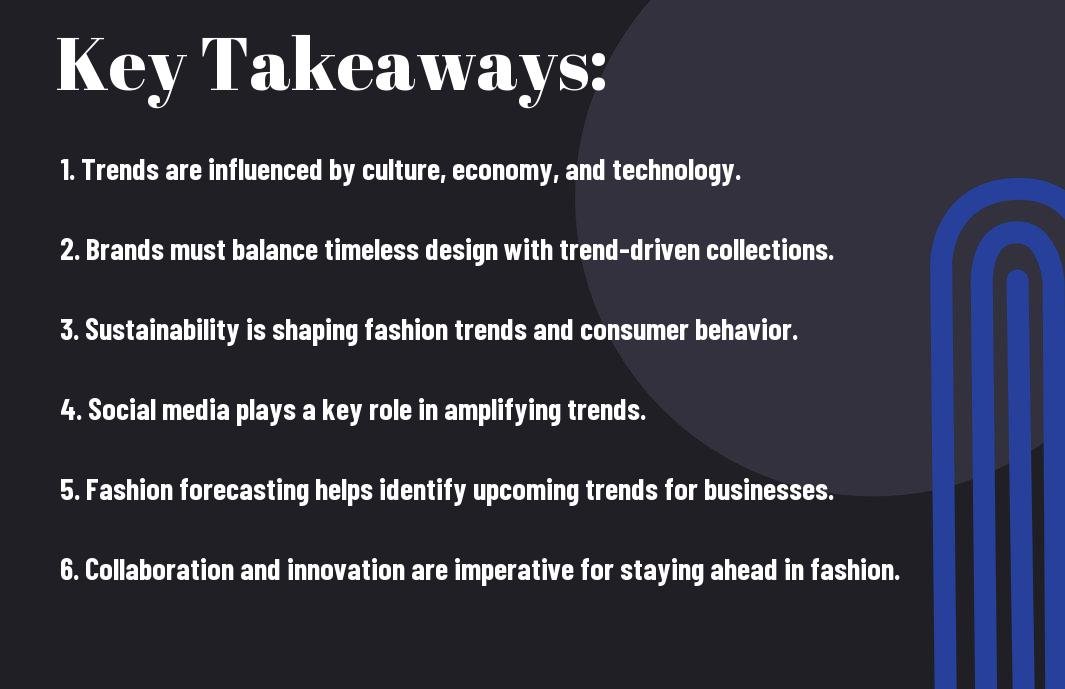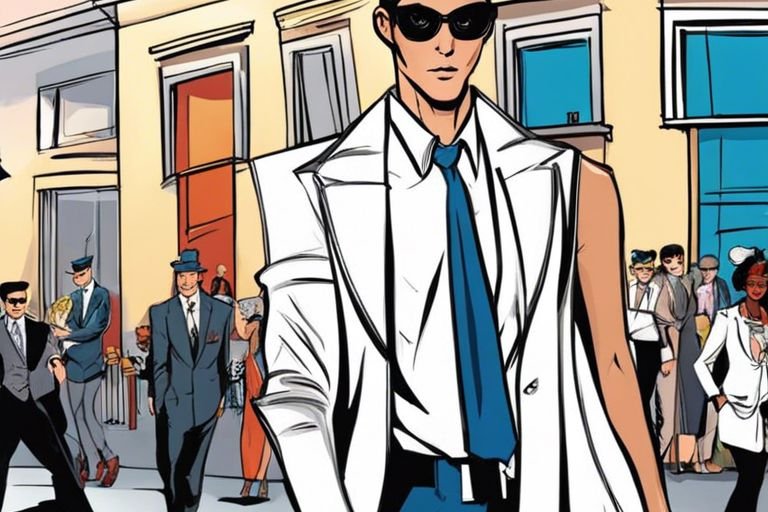
The Business of Fashion Trends
Most fashion enthusiasts are quick to embrace the latest trends without realizing the intricate business mechanisms behind them. Understanding the economics of trends in the fashion industry can provide you with valuable insights into how and why certain styles become popular. From forecasting to marketing strategies, this article probes into the profit-driven decisions that drive the ever-changing world of fashion trends.
Thank you for reading this post, don't forget to subscribe!


The Evolution of Fashion Trends
Historical context: From haute couture to fast fashion
Your understanding of fashion trends cannot be complete without delving into the historical context that has shaped the industry over the years. From the exclusive realm of haute couture houses catering to the elite, fashion trends have evolved dramatically. In the past, trends would trickle down from high-end designers to the mass market at a slow pace, allowing for a sense of exclusivity and luxury. However, with the rise of fast fashion retailers, trends now move from the runway to the store shelves within weeks, catering to the consumer demand for instant gratification.
This shift has democratized fashion, making trends accessible to a wider audience at affordable prices. While this has its advantages in terms of inclusivity and diversity, it also raises concerns about sustainability and the environmental impact of fast fashion. As you navigate the world of fashion trends, it is vital to consider this evolution and its implications on the industry as a whole.
By understanding the historical context of fashion trends, you can gain valuable insights into the present-day dynamics of the industry and make informed decisions as a consumer or industry professional. Whether you are fascinated by the timeless elegance of haute couture or the fast-paced world of trend-driven fashion, acknowledging the evolution of trends is crucial in navigating the business of fashion.
The role of technology in shaping trends
An integral aspect of the evolution of fashion trends is the role of technology. From the way trends are communicated to consumers to the way they are produced and marketed, technology has transformed every aspect of the fashion industry. Social media platforms like Instagram and TikTok have become powerful tools for shaping trends, allowing designers and influencers to reach global audiences instantly.
Understanding the influence of technology in shaping trends is vital for staying ahead in the competitive fashion landscape. Brands that leverage data analytics and AI technologies can anticipate consumer preferences and tailor their designs accordingly, gaining a competitive edge in the market. As you explore the business of fashion trends, keep in mind the significant role that technology plays in driving innovation and shaping industry trends.
The Fashion Industry’s Business Model
It The Business of Fashion Podcast is crucial to understand the business model of the fashion industry. The fashion sector is a complex ecosystem involving designers, manufacturers, retailers, and consumers. Each component plays a vital role in shaping the trends and financial success of the industry. Understanding how these pieces fit together can give you a comprehensive view of the intricate workings of the fashion business.
The supply chain: From design to production
With the supply chain in the fashion industry involves a series of interconnected steps that start with the design concept and end with the finished product in stores. Designers create the initial sketches, which are then transformed into patterns and samples for production. Manufacturers source materials, create the garments, and ensure quality control before shipping to retailers. Along the way, there are logistics, warehousing, and distribution processes that must be managed efficiently to meet consumer demand and trends. Understanding this supply chain is crucial for fashion businesses to stay competitive and adapt to market changes quickly.
The economics of fashion: Pricing, profit margins, and competition
One of the critical areas in the fashion industry’s business model is the economics of pricing, profit margins, and competition. Determining the right pricing strategy involves considering production costs, positioning in the market, perceived value, and consumer demand. Fashion brands often face intense competition, requiring them to balance pricing to attract customers while maintaining healthy profit margins. This delicate balance can make or break a fashion business, as pricing too high can lead to loss of customers, while pricing too low can undercut profitability.
Another imperative aspect of the fashion industry’s economics is the constant pressure to innovate and differentiate to stay ahead of competitors. With fast-fashion brands constantly churning out new designs and trends, traditional fashion houses must find ways to set themselves apart through quality, unique offerings, and brand loyalty. This competitive landscape pushes fashion businesses to continuously evolve, adapt, and find their niche in the market to thrive in the ever-changing industry.
Identifying and Predicting Trends
The importance of trend forecasting
Keep your finger on the pulse of the fashion world by understanding the significance of trend forecasting. Predicting trends is crucial for businesses in the fashion industry to stay ahead of the curve and meet consumer demands. By analyzing consumer behavior, market research, and cultural influences, you can anticipate what styles will resonate with your target audience before they even know they want them. Trend forecasting allows you to capitalize on emerging opportunities and avoid falling behind your competitors.
Methods for identifying emerging trends: Social media, runway shows, and street style
The fashion industry is constantly evolving, and staying current with the latest trends is necessary for success. Utilizing social media platforms such as Instagram and Pinterest can provide valuable insights into what styles are gaining traction among influencers and consumers. Attending runway shows during fashion weeks in major cities like New York, Paris, Milan, and London allows you to witness firsthand the trends that designers are showcasing for the upcoming seasons. Additionally, paying attention to street style can offer a glimpse into how everyday individuals are interpreting and adapting high-fashion trends in their own unique way.
Regarding trend forecasting, a combination of data analysis and creative intuition is key. Trends can emerge from a variety of sources, including pop culture, art movements, and global events. By immersing yourself in diverse sources of inspiration and continuously monitoring shifts in consumer preferences, you can position your fashion business as a trendsetter rather than a follower.
The Impact of Social Media on Fashion Trends
Once again, the influence of social media on fashion trends cannot be understated. In today’s digital age, social media platforms play a crucial role in shaping and driving the latest fashion movements. To probe deeper into this topic, you can check out the article on Fashion Trends: Analyzing Consumer Behavior and Sales.
Influencers and Celebrity Endorsements
Social media has given rise to a new generation of influencers, individuals who have amassed large followings and hold significant sway over their dedicated audience. **Influencers** collaborate with fashion brands, showcase trendy outfits, and attend high-profile events, effectively setting the tone for what’s in vogue. Additionally, **celebrity endorsements** play a pivotal role in elevating certain fashion trends to mainstream success. When a well-known figure wears a particular item or style, it can create a frenzy among consumers eager to emulate their favorite stars.
User-generated Content and its Influence on Fashion Choices
The **creation and sharing of user-generated content** on social media platforms have revolutionized the way **people perceive and adopt fashion trends**. Through **Instagram**, **TikTok**, and other channels, individuals can showcase their unique style, debut new looks, and provide inspiration to others. This democratization of fashion allows for a diverse range of voices and perspectives to shape the industry, leading to more inclusive and dynamic trends that cater to a wider audience.
**Another** noteworthy aspect of user-generated content is its ability to bridge the gap between consumers and brands. By featuring **real people** wearing and styling products, brands can create a more authentic connection with their audience. This grassroots approach to marketing **humanizes** the fashion industry and fosters a sense of community among like-minded individuals who share a passion for style.

Sustainability and Ethics in Fashion Trends
The environmental impact of fast fashion
To keep up with the latest trends, many fast-fashion brands mass-produce clothing at rapid speeds and low costs. This business model leads to significant environmental consequences, such as water pollution, textile waste, and carbon emissions. The constant pressure to produce new collections quickly results in resources being used unsustainably, contributing to the fashion industry being one of the most polluting industries globally.
As you follow fashion trends, be mindful of the impact your choices have on the environment. By supporting sustainable and ethical fashion brands, you can help reduce the environmental damage caused by the fast-fashion industry. Look for clothing made from eco-friendly materials, produced using ethical practices, and designed to last longer than just one season.
By making informed decisions about the fashion you purchase, you can contribute to a more sustainable future for the industry. Consider investing in timeless pieces that transcend trends, supporting brands that prioritize environmental sustainability and ethical production practices.
The rise of sustainable and ethical fashion brands
Sustainable and ethical fashion brands are gaining popularity as consumers become more aware of the ethical implications of their purchasing decisions. These brands prioritize transparency in their supply chains, ensure fair wages for workers, and often use environmentally friendly materials and production methods.
With the increasing demand for sustainable and ethical fashion, more brands are emerging to meet consumers’ desire for clothing that aligns with their values. This shift towards conscious consumerism signifies a growing awareness of the importance of ethics and sustainability in the fashion industry.
Choosing to support sustainable and ethical fashion brands not only benefits the environment and workers in the supply chain but also empowers you as a consumer to make a positive impact through your fashion choices.
The Psychology of Fashion Trends
All businesses need to keep an eye on fashion trends to stay relevant in the ever-evolving retail landscape. According to The State of Fashion 2024 report, understanding the psychology behind what drives these trends is crucial for success in the industry. So, let’s probe into the intricacies of the human mind and its relationship with fashion.
The role of social status and identity in fashion choices
Any fashion choice you make is rooted in your desire to communicate something about yourself. From the brands you wear to the styles you choose, every decision is a reflection of your social status and identity. By aligning yourself with certain trends, you signal to others which group you belong to and what values you uphold. This desire for belonging and self-expression is at the core of why fashion trends hold such power over us.
Moreover, the exclusivity associated with certain trends can drive their appeal even further. When you wear something that is deemed ‘high fashion’ or ‘luxury’, it not only elevates your social status in the eyes of others but also boosts your own self-esteem. This quest for validation and recognition plays a significant role in driving the perpetual cycle of fashion trends.
On the flip side, when a trend becomes too mainstream, it can lose its appeal as it no longer serves the purpose of standing out or signaling uniqueness. This delicate balance between conformity and individuality is what keeps the fashion industry dynamic and ever-changing.
The power of nostalgia and retro trends
To understand the fascination with nostalgia and retro trends, you must recognize the psychological pull of familiar and comforting elements from the past. These trends tap into your emotions, evoking memories of a simpler time or a sense of nostalgia for an era you may have never experienced personally. The warm familiarity of retro styles provides a sense of security and connection in an increasingly fast-paced and uncertain world.
Summing up
To wrap up, understanding the business of fashion trends requires a keen eye for spotting patterns and predicting consumer behavior. By analyzing past trends and staying attuned to societal shifts, you can position yourself ahead of the curve in the fashion industry. Bear in mind, it’s not just about following trends but also about understanding the underlying factors driving them.
Furthermore, tapping into the world of fashion trends involves a mix of creativity, market research, and strategic decision-making. By harnessing the power of data analytics and consumer insights, you can make informed choices that set your brand apart from the competition. Embrace innovation and be willing to take calculated risks to stay relevant in an ever-evolving industry.
Ultimately, the business of fashion trends is a dynamic and thrilling space that rewards those who are willing to push boundaries and think outside the box. By staying curious, adaptable, and connected to your audience, you can navigate the fast-paced world of fashion with confidence and success. So go ahead, embrace the challenge, and let your unique vision shape the trends of tomorrow.
Q: What are fashion trends?
A: Fashion trends refer to the popular styles, designs, and colors that are favored by a majority of people within a specific time period.
Q: Why are fashion trends important for businesses?
A: Fashion trends are important for businesses as they help in determining consumer preferences, facilitating product innovation, increasing sales, and staying competitive in the market.
Q: How can businesses stay updated with the latest fashion trends?
A: Businesses can stay updated with the latest fashion trends by attending fashion shows, monitoring social media platforms, analyzing consumer behavior, collaborating with trend forecasting agencies, and conducting market research.
Q: What are the risks associated with following fashion trends for businesses?
A: Risks associated with following fashion trends include oversaturation of trendy products in the market, short product life cycles, potential losses from investing in unpopular trends, and the challenge of maintaining brand identity.
Q: How can businesses leverage fashion trends to enhance their brand image?
A: Businesses can leverage fashion trends to enhance their brand image by incorporating trendy elements into their products, aligning with the values of their target audience, demonstrating creativity and innovation, and engaging in sustainable and ethical practices.




